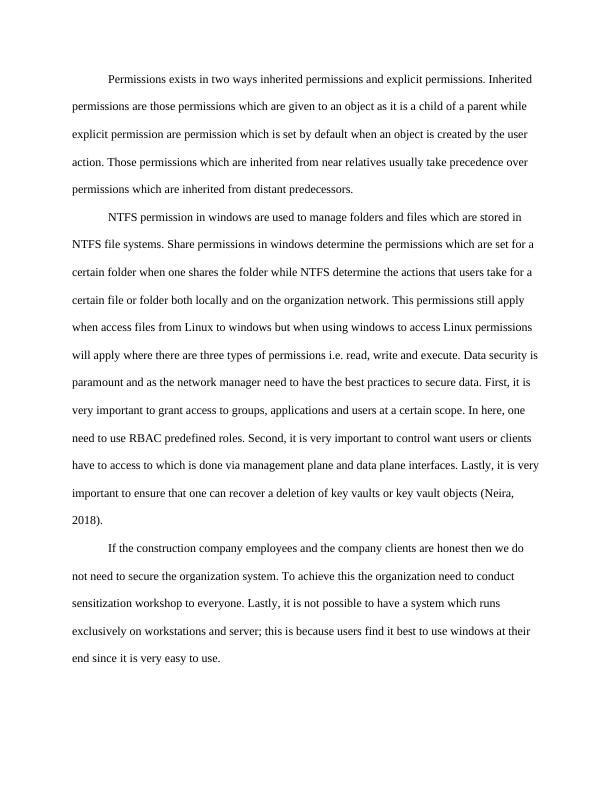Week 2: System Administration - Linux vs. Windows, Server Roles, and Directory Services
Added on 2023-05-27
9 Pages1379 Words138 Views
WEEK 2: SYSTEM ADMINISTRATION
(Student’s Name)
(Professor’s name)
(Course)
(Date)
(Student’s Name)
(Professor’s name)
(Course)
(Date)

Introduction
In week one, as a network manager, I was able to set up Rouge Construction company a
network infrastructure. In addition to this, I was able to choose the best storage option for the
organization where I settled for cloud-based and network attached. Also in week one through a
diagram, I was able to deploy a hierarchical model for the construction Company. In this week,
this paper will give an overview of Linux and windows operating system. Second, the paper will
be updating the existing corporate infrastructure diagram which include server roles where I will
provide an updated labelled diagram. Third, this paper will highlight on directory services where
I will show how the organization need to go about installing the appropriate directory services
and how it would be deployed.
Part A
Linux vs. Windows
Linux file systems are a little bit different than permissions in Microsoft. The file system
in Linux what computer scientists refer to as POSIX standard; this means that every directory
and file is owned by both a group and a user i.e. each and every user is has a primary group
membership; where file created by every user the user who created is automatically given that
ownership. Second, in linux every file has an information node (inode) which store information
about that file which includes even the last modified file, ownership, file size, permissions, and
data block location. Lastly, there are three types of permissions in linux which are group owner
permission, everyone on the Linux system permissions, and owner permission. Windows OS on
the other hand takes its permissions to the extreme where every file can have permissions
assigned to it for any number of groups and any number of users. NTFS permission is the
common type of permission used in windows.
In week one, as a network manager, I was able to set up Rouge Construction company a
network infrastructure. In addition to this, I was able to choose the best storage option for the
organization where I settled for cloud-based and network attached. Also in week one through a
diagram, I was able to deploy a hierarchical model for the construction Company. In this week,
this paper will give an overview of Linux and windows operating system. Second, the paper will
be updating the existing corporate infrastructure diagram which include server roles where I will
provide an updated labelled diagram. Third, this paper will highlight on directory services where
I will show how the organization need to go about installing the appropriate directory services
and how it would be deployed.
Part A
Linux vs. Windows
Linux file systems are a little bit different than permissions in Microsoft. The file system
in Linux what computer scientists refer to as POSIX standard; this means that every directory
and file is owned by both a group and a user i.e. each and every user is has a primary group
membership; where file created by every user the user who created is automatically given that
ownership. Second, in linux every file has an information node (inode) which store information
about that file which includes even the last modified file, ownership, file size, permissions, and
data block location. Lastly, there are three types of permissions in linux which are group owner
permission, everyone on the Linux system permissions, and owner permission. Windows OS on
the other hand takes its permissions to the extreme where every file can have permissions
assigned to it for any number of groups and any number of users. NTFS permission is the
common type of permission used in windows.

Permissions exists in two ways inherited permissions and explicit permissions. Inherited
permissions are those permissions which are given to an object as it is a child of a parent while
explicit permission are permission which is set by default when an object is created by the user
action. Those permissions which are inherited from near relatives usually take precedence over
permissions which are inherited from distant predecessors.
NTFS permission in windows are used to manage folders and files which are stored in
NTFS file systems. Share permissions in windows determine the permissions which are set for a
certain folder when one shares the folder while NTFS determine the actions that users take for a
certain file or folder both locally and on the organization network. This permissions still apply
when access files from Linux to windows but when using windows to access Linux permissions
will apply where there are three types of permissions i.e. read, write and execute. Data security is
paramount and as the network manager need to have the best practices to secure data. First, it is
very important to grant access to groups, applications and users at a certain scope. In here, one
need to use RBAC predefined roles. Second, it is very important to control want users or clients
have to access to which is done via management plane and data plane interfaces. Lastly, it is very
important to ensure that one can recover a deletion of key vaults or key vault objects (Neira,
2018).
If the construction company employees and the company clients are honest then we do
not need to secure the organization system. To achieve this the organization need to conduct
sensitization workshop to everyone. Lastly, it is not possible to have a system which runs
exclusively on workstations and server; this is because users find it best to use windows at their
end since it is very easy to use.
permissions are those permissions which are given to an object as it is a child of a parent while
explicit permission are permission which is set by default when an object is created by the user
action. Those permissions which are inherited from near relatives usually take precedence over
permissions which are inherited from distant predecessors.
NTFS permission in windows are used to manage folders and files which are stored in
NTFS file systems. Share permissions in windows determine the permissions which are set for a
certain folder when one shares the folder while NTFS determine the actions that users take for a
certain file or folder both locally and on the organization network. This permissions still apply
when access files from Linux to windows but when using windows to access Linux permissions
will apply where there are three types of permissions i.e. read, write and execute. Data security is
paramount and as the network manager need to have the best practices to secure data. First, it is
very important to grant access to groups, applications and users at a certain scope. In here, one
need to use RBAC predefined roles. Second, it is very important to control want users or clients
have to access to which is done via management plane and data plane interfaces. Lastly, it is very
important to ensure that one can recover a deletion of key vaults or key vault objects (Neira,
2018).
If the construction company employees and the company clients are honest then we do
not need to secure the organization system. To achieve this the organization need to conduct
sensitization workshop to everyone. Lastly, it is not possible to have a system which runs
exclusively on workstations and server; this is because users find it best to use windows at their
end since it is very easy to use.

End of preview
Want to access all the pages? Upload your documents or become a member.
Related Documents
System Administration: Linux and Windows Integration, File and Print Sharinglg...
|4
|766
|108
System Administration: Directory Services and User/Group Managementlg...
|4
|705
|283
Assignment l File Permissions and Event Viewer.lg...
|11
|1177
|16
Assignment File Analysis Systemlg...
|4
|877
|22
Importance of Active Directorylg...
|5
|796
|437
Demonstration of Computer Security Toolslg...
|13
|3048
|206
